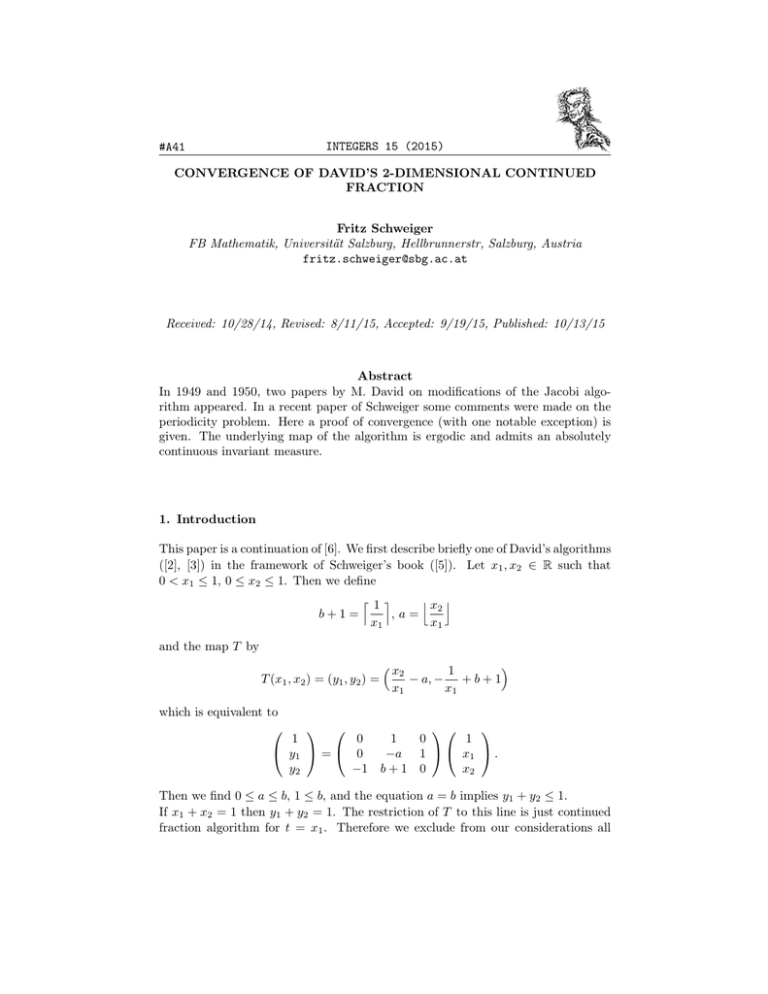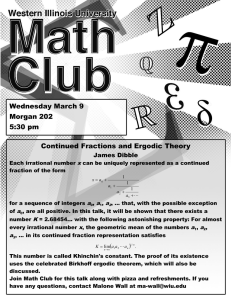INTEGERS 15 (2015) #A41 CONVERGENCE OF DAVID’S 2-DIMENSIONAL CONTINUED FRACTION
advertisement

INTEGERS 15 (2015)
#A41
CONVERGENCE OF DAVID’S 2-DIMENSIONAL CONTINUED
FRACTION
Fritz Schweiger
FB Mathematik, Universität Salzburg, Hellbrunnerstr, Salzburg, Austria
fritz.schweiger@sbg.ac.at
Received: 10/28/14, Revised: 8/11/15, Accepted: 9/19/15, Published: 10/13/15
Abstract
In 1949 and 1950, two papers by M. David on modifications of the Jacobi algorithm appeared. In a recent paper of Schweiger some comments were made on the
periodicity problem. Here a proof of convergence (with one notable exception) is
given. The underlying map of the algorithm is ergodic and admits an absolutely
continuous invariant measure.
1. Introduction
This paper is a continuation of [6]. We first describe briefly one of David’s algorithms
([2], [3]) in the framework of Schweiger’s book ([5]). Let x1 , x2 2 R such that
0 < x1 1, 0 x2 1. Then we define
l1m
jx k
2
b+1=
,a=
x1
x1
and the map T by
T (x1 , x2 ) = (y1 , y2 ) =
⇣x
2
x1
a,
⌘
1
+b+1
x1
which is equivalent to
0
1 0
10
1
1
0
1
0
1
@ y1 A = @ 0
a 1 A @ x1 A .
y2
1 b+1 0
x2
Then we find 0 a b, 1 b, and the equation a = b implies y1 + y2 1.
If x1 + x2 = 1 then y1 + y2 = 1. The restriction of T to this line is just continued
fraction algorithm for t = x1 . Therefore we exclude from our considerations all
2
points on this line and all points with T n (x1 , x2 )1 = 0 for some n 1.
The inverse branches of the algorithm are given by the matrices
1
0
1 0 (1)
( 1)
(0)
B0
B0
B0
b+1 0
1
B
( 1)
(0) C
0 0 A = @ B1(1)
(a, b) = @ 1
B1
B1 A .
(1)
( 1)
(0)
a
1 0
B
B
B
2
2
2
Matrix multiplication gives the recursion relations
(n)
Bj
an = a(T n
1
(n 1)
= (bn + 1)Bj
(x1 , x2 )), bn = b(T n
(n 2)
an Bj
1
(n 3)
Bj
,
(x1 , x2 )), j = 0, 1, 2, n
2.
In [6] the problem of periodicity of this algorithm was discussed. Here we show
that the algorithm is convergent with one obvious exception. The main problem is
related to the fact that not all of the entries of the matrices (a, b) are non-negative.
We further prove the basic ingredients for an ergodic theory of the map T .
2. Proof of Convergence
The characteristic polynomial of the periodic expansion
!
0
(x1 , x2 ) =
1
is
( )=
3
2
2
+1
2
which shows (1) = 0. The two points ( , ) and (1, 1) which correspond to the
eigenvalues = and 0 = 1 are invariant. Here > 1 is the number of the Golden
Section; it satisfies 2 = + 1 and
= 1. Therefore the whole segment between
2
( , ) and (1, 1) is invariant. The algorithm cannot be convergent at all points.
We first observe the following facts. Let
B = {(x1 , x2 ) 2 B : x1 + x2 1}
and
B + = {(x1 , x2 ) 2 B : x1 + x2
1}.
• As already mentioned, the line x1 + x2 = 1 is invariant under the map T . The
restriction of T to this line is equivalent to the continued fraction map. Note
(s)
(s 1)
that qs = B0
B0
obeys the usual relation qs = bs qs 1 + qs 2 . Therefore
we will not consider these points further.
3
• If a1 (x) = b1 (x) then
⇣x
2
y1 + y2 =
x1
Therefore, y = T x 2 B .
• If a1 (x) = b1 (x)
⌘ ⇣
b + b+1
1 and x 2 B
1 ⌘ x1 + x2
=
x1
x1
1
< 1.
then
y1 + y2 =
x2 + 2x1
x1
1
< 1.
Then again y = T x 2 B .
• If a1 (x) = b1 (x)
1 then
|y1 + y2
1| =
|x1 + x2
x1
1|
.
If x1 12 then |y1 + y2 1| 2|x1 + x2 1| . If ag (x) = bg (x) 1 for all g 1
then bg 2 can appear only finitely often. Therefore, in this case, ag (x) = 0
and bg (x) = 1 for g g0 (x).
These considerations imply that the orbit of all points x which are not eventually
excluded by the foregoing considerations will hit a cylinder with 2 b and a b 2
infinitely often.
Theorem 1: If (an (x), bn (x)) = (a, b) with a b
the algorithm is convergent.
2, 2 b, infinitely often then
Proof. : We first state an important property of this
Let
0 (n)
(n 2)
B
B0
n
Y
B 0(n)
(n 2)
(aj , bj ) = @ B1
B1
(n)
(n 2)
j=1
B2
B2
algorithm.
1
(n 1)
B0
(n 1) C
A.
B1
(n 1)
B2
Then the relations
(n)
(n 1)
Bi B0
(n 1)
Bi
hold for i = 1, 2 and n
1.
Therefore the sequences
B1
(n)
(n)
(n)
B0
(n)
B0
(n 2)
0, Bi B0
(n 2)
Bi
(n)
B0
0
(n)
and
B2
(n)
B0
both are increasing. We denote their limit
by x = (x1 , x2 ). Now let x = (x1 , x2 ) be a point with an infinite expansion by this
algorithm. Note that the points x and x have the same expansion.
If T g x = y then
(g)
(g 2)
(g 1)
B
y1 B1
y2 B1
x1 = 1(g)
(g 2)
(g 1)
B0
y1 B0
y2 B0
4
x2 =
(g)
y1 B2
(g)
y1 B0
B2
B0
(g 2)
y2 B2
(g 1)
(g 2)
y2 B0
.
(g 1)
This implies
(g)
B1
(g)
B0
and
< x1
(g)
B2
(g)
B0
< x2 .
Therefore, x1 x1 and x2 x2 .
Since x = (x1 , x2 ) is the limit of the sequence
number g0 such that for all g
g0
⇣
(n)
B1
(n)
B0
(n)
,
B2
(n)
B0
⌘
for any " > 0 there is a
(g)
0 < x1
and
B1
(g)
B0
<"
(g)
0 < x2
B1
(g)
B0
< ".
In the following we restrict to the first coordinate. Then
(g)
x1
B1
(g)
B0
(g)
=
(g 2)
(g 2)
y 1 (B1 B0
B1
(g)
(g)
B0 (B0
(g)
(g)
(g 1)
(g 1)
B0 ) + y 2 (B1 B0
(g 2)
(g 1)
y 1 B0
y 2 B0
B1
(g)
B0 )
)
.
In a similar way we have
(g)
x1
B1
(g)
B0
(g)
=
(g 2)
(g 2)
y1 (B1 B0
B1
(g)
(g)
B0 (B0
(g)
(g)
(g 1)
(g 1)
B0 ) + y2 (B1 B0
(g 2)
(g 1)
y1 B0
y2 B0
B1
(g)
B0 )
)
Now we consider the quotient
(g)
B1
x1
(g)
B0
(g)
B1
x1
⇥
=
(g)
B0
(g)
(g 2)
B1
(g)
(g 2)
B1
y1 (B1 B0
y 1 (B1 B0
(g)
y 1 B0
(g)
y1 B0
B0
B0
(g 2)
y 2 B0
(g 1)
(g 2)
y2 B0
(g 1)
(g 2)
B0 ) + y2 (B1 B0
(g)
(g)
(g 1)
B1
(g 2)
B0 ) + y 2 (B1 B0
(g)
(g)
(g 1)
B1
Assume z = T y and z = T y such that
y1 =
1
a + z1
, y2 =
b + 1 z2
b + 1 z2
(g 1)
B0 )
(g)
(g 1)
B0 )
(g)
.
.
5
and
y1 =
1
a + z1
,y =
b + 1 z2 2 b + 1 z2
then clearly
If a
y1
b+1
2.
y1
b
1 then in a similar way we also get
y2
(a + 1)(b + 1)
4.
y2
ab
If a = 0 we have
y2
z1 (b + 1)
4.
y2
z1b
This shows that the second factor of the product is bounded by 4.
Now we consider the first factor. Let bg+1 2 and ag+1 bg+1
show that
(g)
(g 2)
(g 1)
B0
y 1 B0
y 2 B0
4.
(g)
(g 2)
(g 1)
B0
y1 B0
y2 B0
2. Then we will
We write z = T y and z = T y. Then
(g)
y 1 B0
(g)
y1 B0
B0
B0
=
bg+1 + 1
bg+1 + 1
z2
(bg+1 + 1
⇥
z2
(bg+1 + 1
(g 2)
y 2 B0
(g 1)
(g 2)
y2 B0
(g 1)
(g)
(ag+1 + z 1 )B0
(g)
(ag+1 + z1 )B0
z 2 )B0
z 2 )B0
(g 1)
B0
(g 2)
(g 1)
B0
(g 2)
.
The first factor is bounded by 2. If we assume that the second factor is also bounded
by 2 then we have to estimate the expression
(bg+1 + 1 + z 2
(g)
2z2 )B0
(g 1)
(ag+1 + 2z1
(g 2)
z 1 )B0
B0
from below. Since the points x and x have the same expansion we use
2z1
z1 2
and
z2
We can assume ag+1 = bg+1
(bg+1
2z2
1
.
2 and the lower bound reduces to
(g)
)B0
(bg+1
(g 1)
)B0
(g 2)
B0
.
6
Since the points (z 1 , z 2 ) and (z1 , z2 ) have the same expansion, it is easy to show
that
2z1 z 1 2
and
z2
2z2
1
.
Here we used the invariant segment between ( , 2 ) and (1, 1) as the “worst case”.
If ag < bg then for all x 2 B the inequality B (g) x2 B (g 1) x1 B (g 2) 0 holds
and the proof would be complete.
If ag = bg then we know that ag 1 < bg 1 = d. We insert
(g)
B0
(g 1)
= (d + 1)B0
(d
(g 2)
1)B0
(g 3)
B0
into the expression and obtain
(dbg+1
(g 1)
d + 2 )B0
Note that bg+1
This shows
(dbg+1
d
(g 2)
bg+1 + + 1)B0
(bg+1
(g 3)
)B0
0.
2.
(g)
0 < x1
B1
(g)
B0
< 16".
3. Ergodic Theory of the Map
Theorem 2 The underlying map is ergodic and admits an invariant density.
Proof. Well-known techniques (here I will refer to [5] and to [4]) can be used if we
show that the algorithm satisfies a Rényi condition. We first define a cylinder of
rank g as the set
B((a1 , b1 ), ..., (ag , bg )) = {x : (a1 (x), b1 (x)) = (a1 , b1 ), ..., (ag (x), bg (x)) = (ag , bg )}.
The proof of convergence implies that for almost all points x 2 B, the nested
sequence of cylinders which contain the point x shrinks to this point. If we neglect
a set of measure 0, we have to show the existence of a constant C 1 such that for all
points y and z with y 2 T g B((a1 , b1 ), ..., (ag , bg )) and z 2 T g B((a1 , b1 ), ..., (ag , bg ))
the condition
(g)
(g 1)
(g 2)
B0
y1 B0
y2 B0
C
(g)
(g 1)
(g 2)
B0
z1 B0
z2 B0
7
is satisfied.
We first show that if ag
1 (x)
< bg
1 (x)
and ag bg
2, bg
2 then the estimate
(g)
B0
(g)
(g 1)
B0
3
(g 2)
y2 B0
y1 B0
holds. This inequality amounts to prove
(g)
(g 1)
0 2B0
We insert
(g)
B0
(g 2)
3y2 B0
(g 1)
3y1 B0
(g 2)
= (b + 1)B0
.
(g 3)
aB0
B0
and obtain
0 (2b + 2
(g 1)
3y2 )B0
(g 2)
(2a + 3y1 )B0
(g 3)
2B0
.
We insert (y1 , y2 ) = (1, 1) and obtain
0 (2b
(g 1)
(g 2)
1)B0
(2a + 3)B0
(g)
2B0 .
Since a = ag bg 2 = b 2, the inequalities 2a + 3 2b
true and therefore the original inequality is correct.
1 and 2 2b
1 are
We now have to show that this combination will appear infinitely often in the
expansion of almost all points. We introduce the set
⇤g = {(x1 , x2 ) : a2j
1 (x)
b2j
We will show
1 (x)
2; a2j (x) = b2j (x) for 1 j g}.
\
( ⇤g ) = 0.
g
We first note
0
d+1 0
@ 1
0
a
1
10
1
b+1 0
0 A@ 1
0
0
b
1
1 0
1
db + d + 1
0 A=@
b+1
0
ab + a + 1
1
0
0
Letting x = T 2 y, the chain rule gives the estimate
1
(d + 1)
A.
1
a
1
(2g)
(B0
=
(2g 2)
x1 B0
(2g 1) 3
)
x2 B0
1
(2g 2)
(B0
(2g 4)
y1 B0
(2g 3) 3
y2 B0
) (b2g 1 b2g
+ b2g
1
+1
x1
(b2g
1
+ 1)x2 )3
8
1
(2g 2)
(B0
(2g 4)
y1 B0
(2g 3) 3
) (b2g 1 b2g )3
y2 B0
.
By induction we obtain
1
(2g)
(B0
(2g 2)
x1 B0
(2g 1) 3
x2 B0
)
Then we obtain
(⇤g )
Since
(b1 b3 ...b2g
1
.
3
3
)
1 (b2 b4 ...b2g )
1 1 d 2
1 XXX 1 g
(
) .
2
b3 d3
a=0
b
d=2
1 X
1 X
d 2
1 X
1
X
X
1
1
< 1,
3 d3
3 d2
b
b
a=0
b=1 d=2
the proof is complete.
b=1 d=2
References
[1] Bernstein, L., The Jacobi–Perron Algorithm - Its Theory and Application, LNM 207 (1971),
Berlin/Heidelberg/New York: Springer Verlag.
[2] David, M., Sur un algorithme voisin de celui de Jacobi. C. R. Math. Acad. Sci. Paris 229
(1949), 965-967.
[3] David, M., Sur trois algorithmes associés à l’algorithme de Jacobi. C. R. Math. Acad. Sci.
Paris 230 (1950), 1445-1446.
[4] Ito, S. & M. Yuri, Number theoretical transformations with finite range structure and their
ergodic properties. Tokyo J. Math. 10 (1987), 1-32.
[5] Schweiger, F., Multidimensional Continued Fractions. Oxford Univ. Press, 2000.
[6] Schweiger, F., On David’s 2-dimensional continued fraction. Integers 14 (2014), #A58, 1-9.



